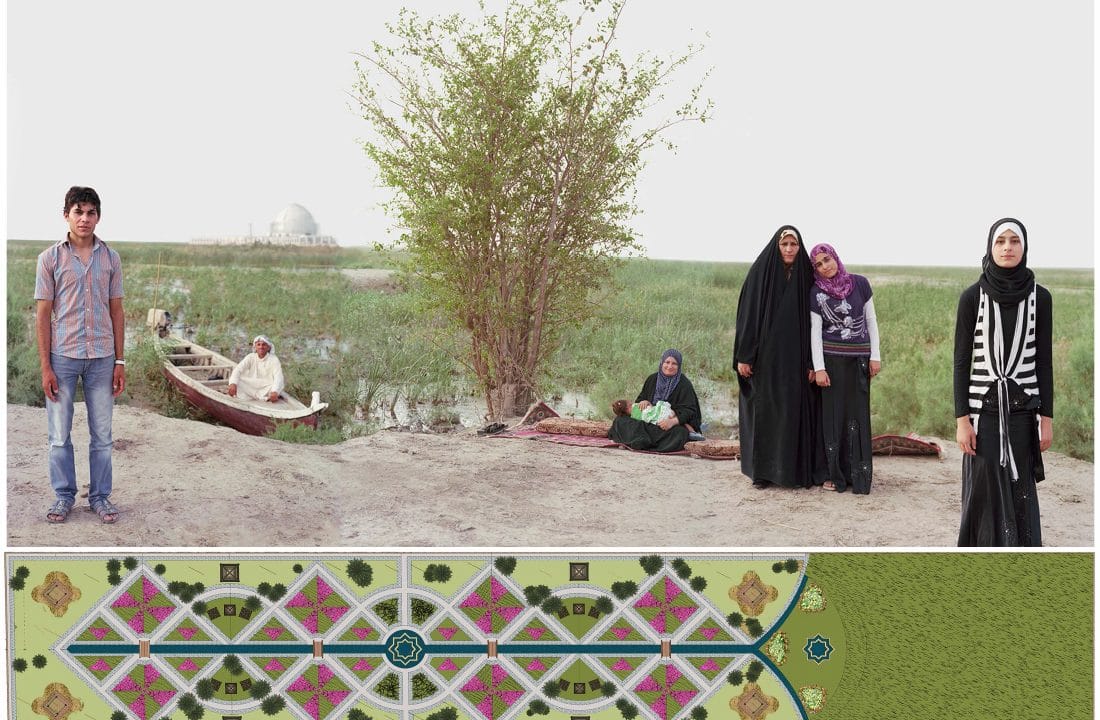Eden in Iraq: The Wastewater Garden Project
BACKGROUND ON THE PROJECT: The Eden in Iraq Project joins environmental art, design, and engineering to create waste and water remediation solution, linking Singapore to the Fertile Crescent of Mesopotamia and Iraq to the New Silk Road. In October 2017, an exhibition at the National Design Centre in Singapore showcased various aspects of the project, from the history and culture of the marshes, to the design process and sources of inspiration for the work.
In 1991 Saddam Hussein drained the immense wetlands near the likely site of the Garden of Eden, turning it into a desert. The expelled Marsh Arabs have been returning to re-green and restore the marshes with the help of Nature Iraq (NGO) located in El-Chibaish. This 7,000 year old Mesopotamian culture has retained their traditional way of life including their magnificent reed architecture, reed weavings, and water buffalo trade. In 2011 Nature Iraq welcomed artist Meridel Rubenstein and environmental engineer Dr. Mark Nelson to create an art/ecological work that will transform human waste into a garden.
We are interested in linking countries emerging from war to the healing transformative power of nature and creating symbols that allow integration of a dark history. To literally transform human waste into a garden, in the vicinity of the Garden of Eden, creates countless associations. To call attention to centuries of destruction through such a simple system is at the heart of EDEN IN IRAQ. To really restore Eden, recognition of waste must be included to make things grow. These small steps of purification and re-greening can help to lead us back from the brink of desertification.
Nelson and Rubenstein visited the southern marshes May 12-26, 2011, to research potential sites. The wastewater art garden project was enthusiastically received and approved by local, provincial and state environmental authorities.
Through Rubenstein’s colleague and industrial designer at the School of Art, Design, and Media, Assistant Professor and Associate Chair, Peer Sathikh, we were awarded in January 2013, a 3 year Tier 1 Research Grant by Nanyang Technological University. We expanded our team, in addition to Peer Sathikh, to include Dr. Davide Tocchetto, environmental engineer and agronomist from Treviso, Italy in research affiliation with Padova University and Dr. Sander Van Der Leeuw, Dean of the School of Sustainability in Arizona State University’s Global Institute of Sustainability and Professor of Human Evolution and Social Change.
Our team will design the first wastewater garden as well as raise funds to build and implement it. With this award we were able to visit S. Iraq for the 2nd time in March 2013 as guests once again of Nature Iraq. There we presented a 4 day Phyto -Remediation workshop for 35 Water specialists from throughout Iraq in connection for the Ministry of the Environment. Drs. Nelson and Tocchetto presented detailed instruction in the wastewater technology and Rubenstein made a presentation on Environmental Design-“Growing Beauty”, introducing ideas of art and design to a scientific audience. The Iraq Ministry of Water Resources officially endorsed our project on paper.

Two Town Councils of nearby villages have given written permission to design and raise funds to build wastewater gardens on 4 sites each serving over 15000 people. Each has allotted two huge sites near their water treatment pumping stations. These stations simply dissolve the waste and then dump it into the Euphrates. These stations will act as much needed giant septic systems for our simple wastewater technology. One town has decided not to use the pumping station at all in order to preserve the Euphrates, so they’re very eager for us to begin. The sites are each 10,000-20,000 sq.meters (2.4-5 acres). We envision a small central Islamic Art inspired garden at the center with groves of Date Palms, Olive trees, and Tamarisk joined by walkways. Iconography on tiles and panels can expand the context of the setting. Native materials, such as woven reeds, recycled glass tiles, and adobe brick can be used in a contemporary fashion resulting in potential cottage industries. A meandering path around the circumference can have resting stations that refer to the Re-Genesis of the area(the return of the water, the birds, the people, as well as circumnavigating the rich history of the marshes originating in Mesopotamia.
We are in the process of preparing drawings for the first garden design as well as itemizing budgets and serious fundraising. Contemporary Arabic artists will be sought to collaborate on design for the 3 successive garden.
Models and drawings were part of the ISEA (International Symposium on Electronic Art) conference in Albuquerque, NM September 2012 in the form of “Eden Again” as research for “EDEN IN IRAQ”.

